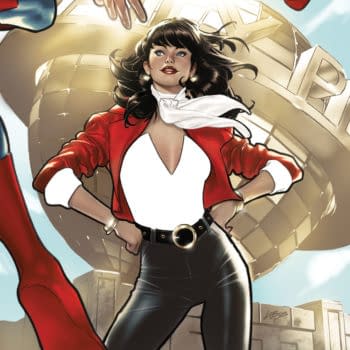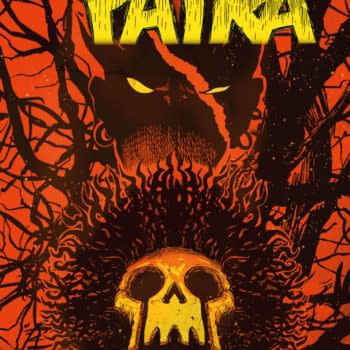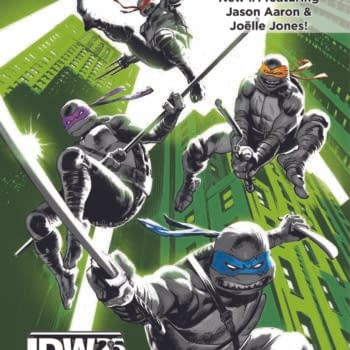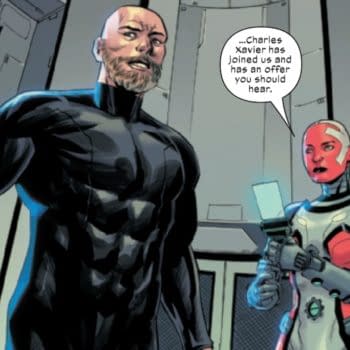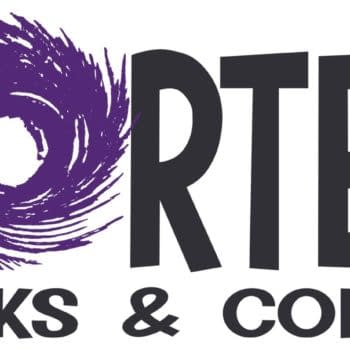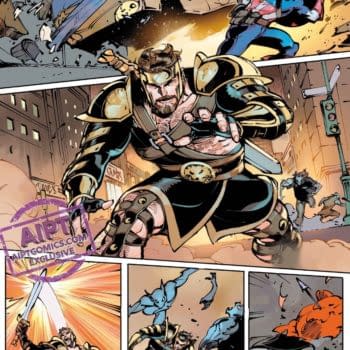Posted in: Comics | Tagged: art young, Comics, duncan fegredo, enigma, entertainment, grant morrison, hellboy, karen berger, kid eternity, mike mignola, peter milligan
Unsung Masterpieces – Enigma With Peter Milligan, Duncan Fegredo, And Art Young
Introducing a new Comics Column, Unsung Masterpieces, in its first installment: Milligan & Fegredo's Enigma
By David Dissanayake
Warren Ellis once wrote that, "American comics are hugely eager to put the future behind them. Last week's books are done and dusted, no matter what. Got to clear the shelves, got to clear space for this week's books, next week's books, all the little pamphlets, the constant unstoppable juggernaut of more new stuff to discard."
Ellis was right. The American comics market has a very short memory. Books that have pushed the boundaries of this wonderful medium we all love are often overlooked and pushed off the shelves to make room for next weeks books. More often than not these unsung classics and envelope-pushing masterpieces are overlooked in general discussion in favor of more established and famous classics like Watchmen, Dark Knight Returns, Maus, or Y: The Last Man whose spot on the shelf at your LCS is assured. But what about those word-of-mouth classics, those lesser known, hard to find, wild-eyed, and groundbreaking books that are still as important to the medium as their more famous counterparts?
That is what this column is about: those sometimes hard to find classics that took the comics medium into terra nova; those utterly unique masterpieces that don't get the attention they deserve. For this column we'll be bringing these books back into the spotlight, complete with interviews with creators, editors, comics historians, and all kinds of other generally badass people. It's going to be awesome.
Now, our very first book for the spotlight is Enigma by Peter Milligan and Duncan Fegredo. Edited by Art Young and published by Vertigo in 1993, the eight issue mini-series was originally slated to be published by Touchstone (Disney's ill-fated adult comics imprint that dissolved before a single release) before being acquired by Karen Berger for Vertigo. The book was the first collaboration between Milligan and Fegredo that lead into other collaborations like Face, Girl, and Marvel's Flowers for Rhino. Unfortunately, Enigma has been out of print for years, but luckily it's not difficult to track down a decently priced copy of the trade (or issues) on Amazon or Ebay.
(In case you're interested, Vertigo's EIC Shelley Bond's Twitter handle is @SXBOND, so feel free to let her know that you'd like a new printing of Enigma. I certainly will be.)
Obviously, I highly recommend you drop what you're doing, put your groceries, debt payments and other expenditures on hold and go purchase the book immediately. It is far more important and also better for your health. I promise.
After a brief and relatively spoiler-free discussion of the book (for those who haven't read it) we have an extensive interview with Milligan, Fegredo, and Young about the book's history, inspiration, process, and impact.
But before we get into Enigma, here are some quotations from other creators about the book to give you a sense of the importance of the story, in case you don't take my word for it:
I've always regarded Peter as the best writer, in the grown-up, literary sense, to have graced the comic book business (as an adult exploration of the superhero concept, I believe his Enigma book is far superior to Watchmen in every significant way). I liked and admired Pete immensely; we had the same sense of humor, and were into a lot of the same stuff – though I always looked up to him as a much more worldly and sophisticated man than I ever felt. – Grant Morrison
There are two comic pages I've bought with my own money. One is from Morrison/Bond's KILL YOUR BOYFRIEND. The other is from Milligan/Fegredo's ENIGMA. Last time I read it, I started an ENIGMA APPRECIATION DAY online. It deserves it. – Kieron Gillen
As anyone who's read Enigma knows, it's one of the primary influences on Young Avengers. – Kieron Gillen
I love Enigma. I remember reading it at my old place, in this house Charles Bukowski used to live once, on a hill overlooking Echo Park in LA. I remember wondering who the narrator of the story would be, I remember being pleasantly lost in the narrative, I remember smiling and thinking this is how you make comics I want to not only read, but also get lost and found in. Enigma is one of the comics I intend to come back to at various points of my life because each reading will be different due to the looseness of certain parts of the idea-packed narrative. It asks me to imagine, it asks me to think, it asks me to feel, it asks me to live. And it explores gender issues that are still rarely explored in our entertainment now. Plus early Duncan Fegredo art! Enigma is art and poetry and inspiring. – Ales Kot
Now, I could never do the story the justice it deserves by trying to re-tell the insanely well-crafted plot, so instead I'll defer to Vertigo's own synopsis:
Enigma is a thought-provoking post-modern tale of self-discovery and sexual identity told against the backdrop of improbable super-heroes and villains. Michael Smith lives a meaningless life of routine and boredom. But when Enigma, his favorite childhood comic book hero, inexplicably comes to life, Smith finds himself on an obsessive crusade to uncover the secret behind his improbable existence. Teaming with Enigma's comic creator, Smith encounters an insanity-inducing psychopath, a brain-eating serial killer, and a suicide-inciting clown posse as his quest uncovers hidden truths about both his idol and himself.
We follow Michael Smith as he leaves behind his old life of tedium and neuroses, his girlfriend, and even his old personality as tries to figure out why his childhood favorite superhero Enigma has come to life, capturing the world's attention as Enigma and his rogues gallery begin living out their comic book battles in real life. As Michael tries to unravel the mystery of Enigma, he also begins unraveling secrets he's been keeping from himself about who he really is. The journey leads us through a deep, wandering, and synchronous pseudo-superhero psychodrama about the shedding of skin and the shifting sands of identity, belief, fiction, and reality. Full of madness, exploration, lizards, and the greatest offbeat "supervillains" this side of Morrison's Doom Patrol, Enigma is simultaneously dark and absurd, yet deeply beautiful and candid.
A truly bizarre story told by the greatest narrator in all of comics, Enigma is, in essence, about identity, repression, sexuality, superheroes, absurdity, and everything in between. It is a very strange book to be sure, and not everyone will like it. More than anything- as Grant Morrison notes in his introduction to the trade paperback- Enigma is about The Truth. If you've ever read any of Milligan's other work, you know that he likes to take the strands of these grand themes and weave them through his stories (see: Shade the Changing Man, X-Force/X-Statix), and the whole story is peppered with the best of Milligan's distinctive black and biting humor. The story opens with a classic line: "It was an ordinary farm in Arizona. The kind of place where you'd have sexual relations with your parents and end up shooting someone."
Of course, it's impossible to talk about Enigma without delving into Duncan Fegredo's beautiful rendering of the story in his inimitable style. One of his earlier works, Enigma showcases Fegredo's early, almost impressionistic style of line work that is beautifully human while exuding a dirty and terrifying scratchiness that grabs the reader and forces them into Milligan's rich and often disturbing world. You can see, even in Fegredo's earlier work, his deft ability to capture the most personal aspects and mannerisms of the characters in the subtlest of ways- the angle of a wrist, the slightest raise in an eyebrow, or a knowing smile. What's interesting about Enigma in particular as an example of his work is that you can literally see Fegredo's style change over the course of the book. It becomes clearer and sharper, more comfortable and at ease. Though apparently unintentional this change in style contributes significantly to the theme of Michael's gradual transformation (there is a funny story about this in the interview below).
Perhaps one of my favorite aspects of Enigma– and one of the reasons the book is so important- is its intricate and layered structure. The story is built in a way that almost everything that is mentioned pays off down the road. Off-handed comments, seemingly random characters met in passing, peculiar words from the narrator- are all full of important allusions and foreshadowing that are invisible on first, and sometimes even second, readings. What is truly impressive about the structure is that it achieves such a high level of complexity and self-reflection, yet it does not feel closed or claustrophobic. Enigma feels loose and free. Even on second and third readings, even when I knew where the story was headed, it still felt open and exploratory, which is a truly masterful achievement.
At this point, it's hard not to draw comparisons to Watchmen. I think the comparison is useful when talking about Enigma's place in the larger comics oeuvre of its time, especially because both books are excellent examples of both adult superhero stories and highly layered, complex plot structures. Both stories have been referred to as superhero "deconstructions," or adult explorations of the superhero concept, and both were succeed in taking superheroes down from their supra-human pedestals, planting them firmly level with the rest of us on our shared human ground. However, while Watchmen used superhero tropes to talk about superheroes, Enigma used superheroes to talk about life and humanity.
Further, both stories have distinctly different models of dealing with content and structure. Watchmen has a level of complexity that, if I may borrow the metaphor from the book itself, feels like a precisely designed watch, with exactly cut gears that fit together perfectly, all spinning together flawlessly in-sync. Enigma, on the other hand, is similarly complex, but feels more warm and organic, like the complexity of a human mind or personality, replete with odd associations and multifaceted emotional resonances. In other words, Watchmen clicks like a perfect clock while Enigma breathes like a living being.
And that is what makes Enigma such a staggeringly impressive work- it is utterly unique and organic in all of its aspects: the story, its execution, its structure, the prose, the art- everything is wholly its own. It remains one of the only (relatively) mainstream comics to tackle the issue of repression, denial, and coming to terms with one's sexual identity in such an inventive and thought-provoking way. Enigma climbed to a new height with its structure and subject matter; a height to which very few works have ever come close. It's Milligan's masterpiece, and that is saying something considering his astonishingly intelligent and well-crafted catalogue of work. The same goes for Fegredo, who's work here looks like no other before or since (though he doesn't agree).
There's not much more I can say about Enigma without ruining the plot or becoming even more redundant that I have already. It is nothing short of a classic that deserves far more attention than it gets. Now if you haven't read it go find yourself a copy immediately, and then you'll understand what I've been ranting about for the past thousand words. Go read it. Go re-read it. It might just change the way you look at the world, and yourself.
Now, without further ado, here is our special in-depth Enigma interview with Peter Milligan, Duncan Fegredo, and Art Young:
David Dissanayake: Before we get into the book itself, could you talk a little bit about the time period when Enigma was published? This was at the beginning of Vertigo's rise, if I'm not mistaken, and the general creativity of its creators seemed to be turned up to 11. What were your personal and creative atmospheres like during this time in your careers and how did it feed into Enigma?
Duncan Fegredo: Enigma was very early in my career. I'd drawn chapters of New Statesmen and Third World War for Crises and had just completed Kid Eternity for DC. All of this was full colour, painted work, something I'd never really intended to do. I'd just completed a degree in graphic design/illustration at Leeds Polytechnic; my final show was all black and white art artwork, which is how comics were predominantly drawn at that time. I graduated and so it seems did the printing process, all of a sudden painted comics were the thing to do. I got the Kid Eternity gig before the Crises work but did the latter first, thinking I would learn to work with color on those smaller chapters before tackling the 150 page behemoth that was Kid Eternity. In retrospect nobody asked me to paint the book, it just seemed the thing to do in the wake of Elektra Assassin and Black Orchid. 150 pages later I had a better understanding of color and new I never wanted to do that again. As it turned out I didn't have a clue how to draw in black and white either…
Peter Millian: You're right, it was a very creatively rich time for comics. There was much less talk or thought of the bottom line. I was really enjoying it and enjoying the creative freedoms that seemed to be opening up. I had either just recently or was about to come off of my long run on Shade the Changing Man. This has been my first series for a US publisher and anyone who read it knows how much I put into it. Towards the end of that I felt my involvement with the character was – at least on a monthly basis – drawing to a close. I really liked the idea of doing shorter mini-series or one-off stories. In some ways these were more similar – in form if not in subject matter – to the stuff I'd done with Brendan McCarthy (see The Best of Milligan and McCarthy, published by Dark Horse). That said, surprising myself I'd become monthly writer on Animal Man. I say surprising myself because when the editor – Art Young -gave me some of the comics to read and asked if I wanted to write it I'd initially answered the negative. I read them again and slowly came about to the idea. I think this had a lot to do with my friendship with Art and the idea of how much fun it'd be to work with him on it. Obviously, my friendship and working relationship with Art is of key importance here, as we're talking about Enigma.
DD: Art, as the ringleader for this whole project, could you talk a little bit about how Enigma came to be? Did you ask Peter to pitch a story for Touchmark? Did you present an idea to him or did he come to you with a fully formed story idea?
Art Young: DC had acquired the Charlton characters, one of whom was Peter Cannon, Thunderbolt. The most odd thing about him (in my opinion) was that he wore a long-sleeved shirt with shorts… Quite an unorthodox (read: insane) look. But his tagline was 'the smartest man in the world' – a concept I thought would appeal to Peter, which it did. I asked Peter to put together a proposal that I could show Karen Berger. However, as we delved into it, there was very little else we liked about the Thunderbolt character. DC had started doing deals for creator-owned properties, so I encouraged Peter to come up with a wholly original character. We also discussed making Michael gay. What was an important layer in the book became an integral part of it: and so the relationship between Enigma and Michael evolved, and became the center of the book. In an incredibly literal case of art imitating life, I was in the process of coming out myself at the time…! So you could say Michael Smith and I came out of the closet together.
DD: How did you all get together on Enigma? If I'm getting my history right, this was your first project all together, and your styles complement each other exceedingly well. Peter's black, bleak, but hilarious sense of humor and Duncan's dark, sketchy, disturbing yet beautifully compelling rendering both coalesce into something truly unique in Comics. How did this partnership begin and unfold?
AY: I met Peter when I was working as Karen Berger's assistant editor. He was doing Skreemer and Shade for us at the time. We hit it off straight away and I really admired his writing. I knew I wanted to work with him when I got the chance to do my own projects. Duncan was an up-and-coming artist whose 'raw', kinetic style appealed to me. He turned out to be a lovely guy to boot. I thought Duncan would be a good match for Peter and Enigma, and so it proved. It was a joy, and delightfully apt, to watch Duncan's rough-and-ready style become smoother just as he – and Michael Smith – became more confident in themselves!
DF: I'd had three editors on Kid Eternity, Karen Berger, Art Young and Alisa Kwitney, one for each book. I think I wore them out, painful as it was to get art from me. Art, apparently was a masochist, and called to see what I was doing after KE, did I want to work with Peter Milligan? Yes I did. I was a big fan of all of Peter's collaborations with Brendan McCarthy, and the idea of working with him was very appealing. I don't recall if Art said it was for a new imprint at Disney at that stage, just that the series was one of three that began with an 'e'… not a lot to go on but I put my faith in Peter. I recall a letter from Art Young, he was writing from a European convention he was attending along with Peter. They had suggestions for Enigma's costume, I think Art may have even sketched something in the margins… I worked up a few sketches, discovered I didn't know how to actually draw but the panting looked pretty cool so it wasn't a completely awful start.
I think Pete, Art and I spoke a few times over the phone and a lot of faxes of scribbles, probably the first time we met was in San Diego to promote Enigma and Touchstone Comics: A book that didn't exist bar a few sketches, one promotional painting, and a company that had produced precisely one promo leaflet and a pin bearing a logo designed by Todd Klein. It didn't hurt that the company was a Disney imprint, and of course the stellar line up of artists and writers for the rest of the company launch. I was more than a little dumbstruck by it all, a little awed by Peter, I was a fan after all, and generally allowed myself to get washed along in the wake of the unfolding events.
Back to reality, I started working on the pages. I'm really not sure what I thought I was doing with the art style, maybe still trying to paint in line after all those pages of Kid Eternity. I was less than happy with the results but thought color would save it. I was excited to see colored pages as Art informed me they would be painted by Sherilyn Van Valkenberg. She'd recently done beautiful work on Fafhrd & The Gray Mouser. Finally seeing the colored pages was a shock, they were just awful, nothing remotely like Fafrd! Such an idiot, the color was fine, I was simply not Mike Mignola!
Around the time I was drawing the fourth issue my line was becoming somewhat less cluttered, more decisive, and my storytelling gained clarity. Meanwhile we had a promotional tour to attend to, Vertigo's Spin Across America tour. Starting out in Austin Texas, finishing in Miami, tour tee shirts with dates on the back and cheesy embroidered denim jackets, what the hell was this? On the flight out I read through an advance copy of the second issue, it was really disheartening. I think I spent the rest of the tour apologizing for it and telling anybody who would listen "It gets better by issue four!" I'm sure I came over as insane. I think it was during an interview in Florida that Pete explained how as the character of Michael became more developed and open within the story I reflected that aspect in the art. "What an amazing challenge for you as the artist!" exclaimed the wide eyed interviewer, "Um, yes…" It was a perfect Milligan moment, divine inspiration served with elegant bullshit, so if it wasn't true before, it became the truth at that moment!
PM: Hah hah. I do remember the moment when I'd explained the artistic rationale behind Duncan's changing art work and style as the book progressed. Yes, there was a degree of bullshittery about it (what had happened was that Duncan had just got better and better, very quickly, over the course of the series). But the best bullshittery has a healthy wedge of truth in it and I did feel that the developing artwork was a kind of perfect visual metaphor for Michael, this half formed or badly drawn man who became more realized as the book went on.
The book began as these things do with me thinking about issues, bringing a few notions together, and quickly moved on to be something that Art and I spoke about. I can honestly say that the book would not have been written, or at least it would not have been written in the same way, if anyone but Art had been the editor. Some of the personal details that Michael goes through, the first time he romantically kisses a man and how different that felt; Art has gone through similar experiences. Art also took me to some very interesting clubs in West Hollywood.
Duncan wasn't the obvious choice for the book. His work in Kid Eternity was great but seemed quite a long way from the feel of Enigma, as I'm sure he'd agree. But there was a quality to his drawing, the way he could capture character, that made Art and I feel it could work. As soon as he began sending character sketches back for Michael and Enigma and some of the other wild characters in the book it was immediately clear he was perfect.
DD: When you were writing Enigma, do you remember what you were inspired by at the time? What music were you listening to, what authors were you reading, which films were you watching, and what artists were inspiring you? Do you remember some of the nice creative ingredients that found their way into Enigma?
DF: I remember reading Fear and Loathing in Las Vegas on the Spin Across America Tour. It made a lot of sense at the time. I passed the book onto Art, a sketch of him reading it appeared in the fourth or fifth issue, I don't recall which. I was looking at the work of David Mazzuchelli, Dave McKean, Bill Sienkiewicz, Kent Williams, Mike Mignola, Brendan McCarthy, Alex Toth and Steve Yeowell, I'm sure there were others. There was something I wanted from each of them. No wonder I was artistically conflicted!
PM: I know I was reading Seven Pillars of Wisdom by T.E. Lawrence (Lawrence of Arabia). Bizarrely, I was listening to a bit of baroque and Renaissance music – Gregorio Allegri and John Dowland – and some punk and garage: though I'm not sure what any of that found its way into Engima. I think RAGE, a pretty intense bar that – in the spirit of research – Art took me to in Hollywood, had more of an impact. As a straight man it was an interesting experience.
DD: So, in theory, what would have happened in the story if it were to have continued? Obviously it was designed as a limited series, but did you have any other story ideas if Enigma were to have continued? Or did Mother kill them all?
PM: I kind of think Enigma would have persevered, one way or another. But the story was specifically designed so that it avoided the usual and perhaps expected fight at the end. I thought that by avoiding, by leaving us at the cusp of that conflict, we were saying that that the outcome of a big fight was not what this story has been about.
DF: I never saw it as anything other than self-contained, happy for those characters to walk off into the frame, into their unmapped future. I hadn't pressed Pete for details about where the story was going, happy to be surprised as the story unraveled. I was presented with the final script at UKCAC, and read it in a bathroom stall, the only quiet place I could find. My mind was blown as I read the reveal, all the pieces tumbled into place and I was utterly satisfied. Good job I was sitting down…
DD: What's the deal with Enigma being out of print for so long? The same question for Face and Girl as well? Is there any chance we'll finally see a collection of all three, maybe? I'll put money down and buy five right now.
DF: I have no idea, it's irksome to say the least. I'd love a collection of all our Vertigo collaborations but the company it would seem could care less.
PM: I agree. I hear rumors. So far they've amounted to nothing. I continue to be optimistic, with a shot of ironic pessimism.
DD: Now Peter, I'd like to ask you some questions about the writing side of things before talking to Duncan about the art. What was the creative inception of Enigma? How did the idea of the story arise and how did you begin to fit all the different moving parts together? Did it begin as a superhero story, a story about finding and coming to terms with one's sexuality, or as story about a Lizard speaking to its uncomprehending brethren?
PM: It's often difficult to pin-point what aspect of story got the ball rolling, because usually it's a coming together or a few different ideas. But I think in the case of Enigma my initial thoughts were about this lone figure with an incredible mind and the strategies he uses to live. From here grew the idea of the lizard, but more importantly I began think about the person who would go after this "enigma". The idea of this man being an unrealized gay man grew. From there it fell together. At no time was it ever going to be a regular superhero book.
DD: Is Enigma a superhero deconstruction? Many have compared it other deconstructionist pieces like Watchman, Dark Knight Returns and other similar work. Was this your intention, or did you have something else in mind? It seems to me that Enigma is so much more than just a take on superheroes, and it seems to reduce Enigma by just calling it superhero deconstruction.
PM: I think you're right. Enigma doesn't use a story as a way of looking at superheroes. It uses a superhero to look at life, the particular life of a man who thinks he is on a journey to find his boyhood hero but discovers that it's about self-discovery. Yes, there's a meta superhero in the beloved comic book Michael's youth, and yes there are what you might call supervillains in the story, but above all the lizards and envelope girl's Enigma becomes very much Michael's story.

PM: Identity and sexuality is at the core of Enigma. What Michael goes through is, for him, much deeper and more fundamental than simply the kind of sexual preference he has. It is a root and branch re-constituting of his self. The "drug" called Michael Smith from which he is the ersatz Michael Smith, a Michael Smith who seems strangely disconnected. I suppose there is a larger philosophy in there but I'd hate to give it a name or boil it down to some glib platitude. I think we've established just how much I hate glibness. Moving on, on the subject of identity, I often thought that Enigma's own identity is only brought into proper being by Michael and Michael's obsession with him.
DD: It seems that Michael's personal battle with his own identity is more the focal point of the story rather than The Enigma's mysterious secret origin. Why did you choose a superhero as the engine for this tale of Michael's personal reckoning, and what was it about superheroes that lent itself to this tale of identity and sexuality?
PM: As I said, these things grow organically. There are many other ways of telling the story of a personal journey like this one. But I wanted it to be more than that, or at least to tell that story in a different way, a way that a comic book, with comic book readers and genre expectations, is uniquely equipped to tell.
DD: So just a little shop-talk here, what is your writing process like, particularly for this story? It's incredibly intricate, interconnected, and well planned. How do you go about putting that all down on paper and drawing the connections between everything?
PM: There is a degree of pulling out of hair. Lots of notes, on different bits of paper, stuck all over the wall. And then what I like to do is discover or refine the core story. The strange connections and intricacies are related – or deliberately unrelated – to this core story. From then on it pretty much writes itself (hah hah).
DD: Alright Duncan, now about your end of things! Your style has changed a good deal since some of your earlier works with Peter. What was your approach to the art of Enigma, and how did it differ from your approach to your more modern works like Hellboy and (from what we've seen of) MPH, which have a distinctly different feel from Enigma, Face and Girl?
DF: Enigma was a learning process, trying to create order out of chaos. Much of the chaos came from trying to make sense of the various artists who influenced me, most of which were contradictory. In retrospect the answer was simple, less style, more substance. Everything after was a continuation of that theme, trying not to be showy but concentrate on drawing a performance out of characters, evoke a response in the reader to enhance the story. With later books I tried to add a stylistic sheen over the drawing. On X-Force I purposely tried to echo the work Mike Allred had been doing on the title. I was still drawing as I do but I felt it gelled better with the world Mike had created. For Monsters on The Prowl with Steve Niles I tried to channel Jack Kirby in the same way, it was still very much me but I felt the story harkened back to classic Marvel and Jack Kirby, it made it a lot of fun to draw. I doubt I'll ever draw a book like that again because it got that nostalgic need out of my system.
I suppose Hellboy is the culmination of that approach, taken to the extreme. I came to Hellboy as a fan, and as I fan I needed there to be some sense of continuity in the book. I wasn't asked to emulate Mike Mignola and I really wasn't trying too. I was trying to distill elements of the world and language Mike had created and bring it into my own work, in as natural a way as I could. It turned out to be more complicated than that as the differences were more than skin deep but I think I found a reasonable balance after a while, both stylistically and from a storytelling point of view. With MPH I'm returning to a similar approach to my work with Peter I suppose…. But here's the thing, it's always just drawing.

DF: It was chaos. I'd scribble layouts and notes all over the scripts, translate those into scribbly pencils and then fax them to Art and Peter. I don't recall much back and forth about them, I was largely left to my own devices to just get on with it. In the earlier stages of the book I drew with a Pilot Hi-Tec pen (I think that was the name…), it had a hard point and very uniform line and lent itself to all those scratchy lines. Around #4 I happened upon a marker pen designed for overhead projectors, I really liked the quality of line, it was much broader and rather than scratching images onto the paper I found myself drawing with a rather more deliberate line, all of a sudden less was very much more. I never discussed color with Sherilyn, only really spoke with her the once at a DC party, but she did a great job considering the horrors she had to work with, at least initially.
My only considerations regarding color were regarding the covers and they were rather instinctual. I designed pretty much all of the covers in one sitting, so I guess I must have had a synopsis for all 8 issues… Is that right or do I just remember it that way? I'm sure I have a sketchbook somewhere with all the covers in, one after the other, colour notes included. My one moment of clarity, if it is true!
DD: Do you tend to stick closely to Peter's script or do you take a little bit of control with the layouts and panel counts?
DF: I always have tried to follow scripts as close as I can, making adjustments if I think I can improve the storytelling. I'm more likely to add panels rather than subtract. The one moment of divergence I can recall on Enigma concerned the confrontation with The Truth in the cathedral. For some reason I decided to make The Truth mutate into a giant, I'm sure it wasn't in the script. I think it was my idea of a visual metaphor; none too subtle. Pete just worked around it, and deflated The Truth and defeated him in the process. Very appropriate. Largely Pete would write, I would draw, and we just got on with it. We spoke a few times on the phone and at conventions but that was it, we trusted each other to do what we do. It was different working with Mike Mignola, obviously as an artist he had his own ideas on how certain things should play out on the page. It probably bugged the hell out of him that I was adding panels here and there as it played havoc with his story beats, but gradually we adapted to each other and the book got better as a result of that.

AY: I'm extremely proud of it, and delighted that it was received so well. When I was working on Hellblazer with Karen, I always wanted Constantine to wake up with a man at the start of one issue for a change – and there to be absolutely no weirdness for him and no comment on it. So Constantine is bisexual, no big deal – he's certainly done more bizarre things than that! Before I could make this suggestion, however, I was promoted and could now develop my own stable of books. So I was able to have my gay character in Enigma. I deliberately didn't tell the Marketing department that Michael was going to be gay. As it would have garnered a lot of publicity, they were very cross when they eventually found out! But I didn't want Enigma to be marketed as a 'gay comic' and I knew it would've been. I was afraid too many people would think that wasn't for them – and that would damage sales, the last thing I wanted for Vertigo's flagship creator-owned title. Mostly, I wanted people to discover Michael's sexuality at the same time he did.
DF: It's still as affecting a story as it ever was, every bit as mind blowing. I'm talking of the story mind, I can't really look at the art, the first half at any rate. I don't recognize the guy who drew it, just the anxieties over its many shortcomings. People still tell me it's their favorite work, which is great, but I can't understand it. It may be they see what I was trying to do, the mindset that reacted and tried to work with Peter's words, in a way that I no longer can. It's funny, as fast as I was developing as an artist I recall Karen Berger asking me not to change too much. I think she was concerned over losing any sense of continuity. The strange thing is that the changes in my work really was the continuity, Peter's glib observation of my changing art reflecting the story was on the button, whether it was intentional or otherwise!
PM: Glib? I think we've established that my observation wasn't glib. I still think Enigma works. It still manages to be both very weird and emotionally moving, and I think that's no little thing. However there is one scene that I'd love to go back and change. It was a complex point to get across and I didn't manage it. It's the scene where Titus makes a pass at Michael, and Michael hits Titus. I think dramatically that's right: Michael was in deep denial. But in retrospect I wouldn't have Titus apologizing: that comes too close to condoning violence. I wanted to get across the idea that Titus was trapped in his own expectations and societal prejudices. Maybe believing his actions deserved a punch. I think that was too subtle, or at least I didn't handle it correctly. But besides that I like a lot of it. I look back very fondly at the book, and at that time in my life, creative and personal.
DD: I know you're both very busy at the moment with different projects, but will we ever see another Milligan/Fegredo collaboration?
DF: I'm proud of the work I've done with Pete, I was fortunate to have had the opportunity to work with him and learn along the way. The way he wrote made me rise to the challenge of imbuing the characters with a life to match. There is always the possibility of more.
PM: Yes. I'd love to work with Duncan again. Who knows?
Alright folks, that does it for our first installment of Unsung Masterpieces. I hope you enjoyed it as much as I did. Go buy Enigma as soon as you can, and don't forget to let Vertigo's Shelly Bond (@SXBOND) know that we all want a new printing! Stay tuned next time for our next Unsung Masterpiece!
David Dissanayake is Washington DC correspond for Bleeding Cool. He loves comics, perhaps a little too much. Give him a shout @dwdissanayake on twitter.













